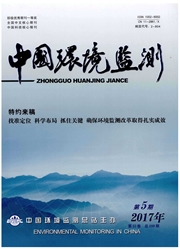

 中文摘要:
中文摘要:
结合当地气象条件,采集了安徽某燃煤电厂周边地区的土壤,采用冷原子吸收法测定其汞含量,应用地统计学和地理信息系统方法分析了电厂周边表层土壤汞含量的空间分布特性,分析了土壤中汞与理化性质之间的相关性,并进行了风险评价。结果表明,电厂周边表层土壤汞含量范围为0.015~0.076 mg/kg,平均值为0.029 mg/kg,虽未超过国家允许的标准,但与当地背景值及安徽省土壤汞含量相比均有一定程度的增加;土壤汞含量的总体分布特征为除距排放源1~2 km的环形区域受影响最大外,污染程度随着与电厂距离的增大而递减,汞含量空间分布受主导风向影响呈现明显的条带分布。相比于单因子污染指数法和地累积指数法,潜在生态危害指数评价法能更好地反映燃煤电厂周围土壤中汞的污染水平和生态风险程度。土壤汞含量与土壤理化性质之间存在不同程度的相关性。
 英文摘要:
英文摘要:
Samples of soil around a coal-fired power plant were collected and the concentrations of Hg were determined through the CVAAS method. Spatial distributions and risk assessment of Hg in soils around the power plant were investigated by using geostatistics and GIS techniques. The results showed that Hg concentration in soil ranged from 0. 015 to 0. 076 mg/kg, with an average of 0. 029 mg/kg,which was higher than that in local area (0. 015mg/kg) and Anhui(0. 027 mg/kg) , but lower than the secondary standard value of" soil environmental quality standards"( GB 15618--2008). The overall distribution characteristics of Hg showed as the followings: distance between 1 km and 2 km away from the plant 〉 within lkm 〉 distance of 2 km away from the plant,Hg had obvious decrease by the distance. The spatial distribution of Hg content had a high correlation with the dominant wind directions,pointing to a potential Hg input from coal combustion. Compared with the method of single factor pollution index and geoaccumulation index,Hakanson single potential ecological risk index evaluation better reflected the actual pollution levels of soils and its hazard to surrounding environment. Hg concentrations in soil have different correlation with pH and organic matter(OM).
 同期刊论文项目
同期刊论文项目
 同项目期刊论文
同项目期刊论文
 期刊信息
期刊信息
